|
|
|
Sort Order |
|
|
|
Items / Page
|
|
|
|
|
|
|
| Srl | Item |
| 1 |
ID:
046845
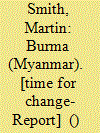

|
|
|
|
|
| Publication |
London, Minority Rights Group International, 2002.
|
| Description |
44p.
|
| Standard Number |
1897693591
|
|
|
|
|
|
|
|
|
|
|
|
Copies: C:1/I:0,R:0,Q:0
Circulation
| Accession# | Call# | Current Location | Status | Policy | Location |
| 045728 | 959.106/SMI 045728 | Main | On Shelf | General | |
|
|
|
|
| 2 |
ID:
147252
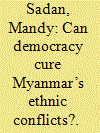

|
|
|
|
|
| Summary/Abstract |
“Burmese politicians of all persuasions…seem to be equally bereft of inspiration for negotiating a path to a peaceful and inclusive state in which the hopes and aspirations of non-Burman and non-Buddhist communities would be protected.”
|
|
|
|
|
|
|
|
|
|
|
|
|
|
|
|
| 3 |
ID:
124904
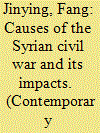

|
|
|
|
|
| Publication |
2013.
|
| Summary/Abstract |
As the civil war drags on, sectarian killings are increasingly brutal, and Islamic jihadist forces are emerging as strong players in Syria. Meanwhile, refugees, sectarian and ethnic conflicts, geopolitical maneuvering and violence are spilling over into neighboring countries. Syria is likely becoming a Somalia in the Middle East, escalating instability in the whole region.
|
|
|
|
|
|
|
|
|
|
|
|
|
|
|
|
| 4 |
ID:
072823
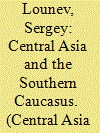

|
|
|
| 5 |
ID:
153686
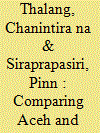

|
|
|
|
|
| Summary/Abstract |
Peace negotiations are shaped not only by the agents of conflict, but also by the structures in which they interact. From a comparative perspective, this article examines how both structural and agential factors have influenced the trajectory of the peace processes in Aceh and in Thailand’s southern border provinces.
|
|
|
|
|
|
|
|
|
|
|
|
|
|
|
|
| 6 |
ID:
108691


|
|
|
|
|
| Publication |
2009.
|
| Summary/Abstract |
Notwithstanding predictions over the past century and a half that minorities defined in ethnic, linguistic, or cultural terms would gradually reconcile themselves to coexistence in states dominated by metropolitan cultures, difficulties arising from the mobilization of minority communities continue to be pronounced at the beginning of the twenty-first century. This article provides an overview of the extent of ethnic division in modern states, describes characteristic patterns of ethnic mobilization and focuses on a smaller set of illustrative cases that reveal many of these patterns. In this, it defines the context for a set of case studies that follow: Belgium, Spain, Northern Ireland, Bosnia and Herzegovina, Cyprus, Lebanon, South Africa, and Sri Lanka.
|
|
|
|
|
|
|
|
|
|
|
|
|
|
|
|
| 7 |
ID:
092938
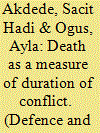

|
|
|
|
|
| Publication |
2009.
|
| Summary/Abstract |
This paper introduces a new measure of conflict duration and argues that the number of deaths in a conflict can serve as such a measure. The paper demonstrates that there are information gains to this approach. The well-known conflict database of the International Peace Research Institute is compared with the database of the Center for Systemic Peace, which includes data on the number of deaths in addition to length of conflict. The number and distribution of conflicts vary; however, duration analysis based on the conventional measure of duration yields results that are robust over the above-mentioned datasets. We also show that the number of deaths, as a measure of duration, challenges some of the results based on the number of years as a measure of duration. In the 1990s, the duration of conflicts is significantly different from before when the duration measure is the number of years - we do not find a statistically significant distinction when the number of deaths is used. Ethnic conflicts have a longer survival time in terms of time but not in terms of number of fatalities.
|
|
|
|
|
|
|
|
|
|
|
|
|
|
|
|
| 8 |
ID:
112967
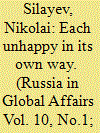

|
|
|
|
|
| Publication |
2012.
|
| Summary/Abstract |
After gaining independence, Georgia, Armenia, and Azerbaijan have been plagued by wars and ethnic conflicts, they have lost transport links, and government agencies have collapsed. Yet the respective political regimes have had diverse fates: although the starting points and international situation were similar when they launched their policies, the outcome is fairly different.
|
|
|
|
|
|
|
|
|
|
|
|
|
|
|
|
| 9 |
ID:
099107
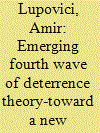

|
|
|
|
|
| Publication |
2010.
|
| Summary/Abstract |
In this paper, I aim to review recent empirical and theoretical developments in the study of deterrence. I suggest that an emerging wave of literature currently represents a revival in this field. However, unlike the previous waves, in which theoretical and empirical questions were studied together (realism and nuclear deterrence), in the emerging deterrence literature these two are isolated from each other. The theoretical trend of this wave is evident in new constructivist and interpretative scholarship that explores the practices of deterrence and has provided significant insights, chiefly with regard to classical empirical questions of state versus state and nuclear deterrence. The empirical trend of this wave can be seen through the work of scholars who are considering how to deter "new" threats-such as terrorism, rogue states, and ethnic conflicts-mainly by incorporating the traditional realist approach to deterrence. By reviewing these two trends in the current wave of deterrence writing, I demonstrate the advantages of each and suggest that the study of deterrence may benefit from their integration.
|
|
|
|
|
|
|
|
|
|
|
|
|
|
|
|
| 10 |
ID:
138118
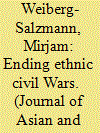

|
|
|
|
|
| Summary/Abstract |
At the beginning of 21st century (ethnic) civil wars have been proliferate all over the world. Many ethnic conflicts – for example the conflict in Sri Lankan between the Sinhalese majority government and the guerrilla fighters of the Tamil minority – are characterized by constant efforts for conflict resolution interspersed with renewed violence, with cycles of military escalation and de-escalation. Also, they are marked by the helplessness of the international actors, who profess their interest in a resolution and try to mediate between the contending parties. But they are rarely successful – why? I assume that the most important question in war and peacetime is whether security is possible to achieve to prevent the security dilemma escalating. In many Asian and African countries people perceive politics and security in ethnic terms. Thus how a party defines security is of decisive importance concerning whether a conflict can end in peace or will be solved militarily. Within an exclusive security concept, security can only persist if the other is annihilated or oppressed by military means, while inclusive security concepts can achieve security by special arrangements, peace agreements or security guarantees. Third parties, who are engaged in mediating violent conflicts, have to keep in mind that it is the elusive balance of these security schemes which determine successful negotiations and at least a permanent solution. To reach a lasting peace it is not sufficient for external actors to provide security; in the long run, they must transform exclusive into inclusive security concepts.
|
|
|
|
|
|
|
|
|
|
|
|
|
|
|
|
| 11 |
ID:
126645


|
|
|
|
|
| Publication |
2013.
|
| Summary/Abstract |
This paper considers the recruitment of volunteer levies into British forces in northern Burma during the Second World War. Using data compiled by a local veterans' association, the paper raises questions about the supposed historical continuities that are believed to exist across military forces of the pre- and post-war periods. The data indicate that prevailing assumptions about the motivations and aspirations of local recruits should be challenged more than they have been to date. The author proposes new approaches to using quantitative data to reveal broader social trends in issues of military recruitment that could be extended into other times and places. Such methods could be particularly helpful in facilitating deeper and more nuanced demographic and social insights into Burma's history of internal militarized conflict and the ways in which recruitment practices relate to the communities from which recruits are drawn.
|
|
|
|
|
|
|
|
|
|
|
|
|
|
|
|
| 12 |
ID:
108703
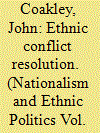

|
|
|
|
|
| Publication |
2009.
|
| Summary/Abstract |
This article generalizes on the basis of a set of case studies of ethnic conflicts that have followed different routes towards the goal of a long-term settlement: Belgium, Spain, Northern Ireland, Bosnia and Herzegovina, Cyprus, Lebanon, South Africa, and Sri Lanka. It begins by reviewing the significance of ethnicity in the modern state, exploring the political implications of different terminologies in this area. Having examined the patterns of political mobilization of ethnic groups (whether in the form of the party system or in the shape of military-type formations), it looks at the kinds of political outcome that have been associated with settlement processes. In addition to "solutions" that would be regarded as politically unacceptable, it identifies three common features which, depending on specific local circumstances, commonly occur: federal or other territorial arrangements, consociational government, and the political integration of minorities.
|
|
|
|
|
|
|
|
|
|
|
|
|
|
|
|
| 13 |
ID:
173525
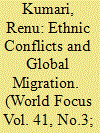

|
|
|
|
|
| Summary/Abstract |
Global human migration in the 21st century has emerged as a daunting challenge. The United States, European Union, Australia and others count migration amongst many of the security challenges confronting them. Though human migration is not a new phenomenon, yet post-Cold War the problem has intensified. The global attention shifted from industrially developed Europe to newly created states Asia and Africa.
|
|
|
|
|
|
|
|
|
|
|
|
|
|
|
|
| 14 |
ID:
130903
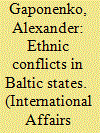

|
|
|
|
|
| Publication |
2014.
|
| Summary/Abstract |
To my mind, the European Union - EU was planned as strictly an economic union and its founder did not plan right from the start to form a single European community of nations or even a European civilization of a higher level.
|
|
|
|
|
|
|
|
|
|
|
|
|
|
|
|
| 15 |
ID:
171996
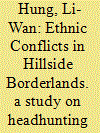

|
|
|
|
|
| Summary/Abstract |
This article examines ethnic conflicts in hillside borderlands, with special emphasis on the tradition of headhunting. Moreover, this study investigates how the self-autonomous new settlers negotiated with the aboriginal tribes to establish their living space, as well as the social relationships that were formed as a result. The findings of this study reveal, on the one hand, the multiple meanings of the headhunting custom and its evolution following the influx of new settlers and under Qing statecraft, and, on the other hand, shed light on how immigrants established their living space in the face of complex ethnic relationships and conflicts in the hillside borderlands. Although the practice of headhunting did not have its roots in conflicts between mountain inhabitants (shengfan) and plains immigrants (shufan and Han Chinese), changes in the nature and scale of headhunting in the eighteenth and nineteenth centuries were the result of the mass influx of new settlers and state intervention. In borderland regions where government authority was not well established, immigrants were left to fend for themselves and were much affected by the local cultural environment. Hence, when analysing the development of immigrant society or local history, due attention should be paid to the social traditions and characteristics of native inhabitants, which often provided the background and underlying reasons for ethnic conflicts.
|
|
|
|
|
|
|
|
|
|
|
|
|
|
|
|
| 16 |
ID:
174175
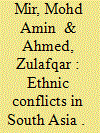

|
|
|
|
|
| Summary/Abstract |
For long, South Asia has been an epicentre of conflicts including ethnic, political, religious and social clashes. Mohd Amin Mir and Zulafqar Ahmed examine why ethnic conflicts have emerged in South Asia, their repercussions on societies and states, their impeding of regional cooperation and the best way forward for reaching solutions.
|
|
|
|
|
|
|
|
|
|
|
|
|
|
|
|
| 17 |
ID:
129468
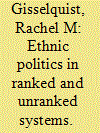

|
|
|
|
|
| Publication |
2013.
|
| Summary/Abstract |
This article explores how ethnic politics may operate differently in societies with "ranked" versus "unranked" ethnic systems, where ethnicity and class correlate closely versus very little. It focuses on two hypotheses suggested, but not tested, in Donald Horowitz's Ethnic Groups in Conflict. Their plausibility is explored in seven brief case studies of electoral politics in South America and Southern Africa. The analysis suggests that theories of ethnic politics that fail to take class into account are problematic for the study of ranked societies in particular.
|
|
|
|
|
|
|
|
|
|
|
|
|
|
|
|
| 18 |
ID:
131987
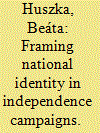

|
|
|
|
|
| Publication |
2014.
|
| Summary/Abstract |
During secessionist mobilization in a multiethnic environment, the use of a discourse that excludes minorities can create internal enemies; meanwhile, co-opting minorities through inclusive framing can turn them into allies. From the standpoint of what sort of identity constitutes the basis of a nationalist movement, my fundamental argument is that the most crucial factor is whether there is a widespread perception of internal threat associated with the presence of a local minority. The chance of such perceptions of a threat emerging among the majority increases if the minority is politically linked to the center or a neighbor that is hostile to the movement. Yet, this explanatory model can show only a tendency depending on the structural setting; it cannot explain the timing and nature of identity shifts. I demonstrate that it is possible to include previously excluded minorities into the national collective through a reframing of national identity, and that the explanation of ethnic exclusion cannot be reduced to a simple ethnic security dilemma.
|
|
|
|
|
|
|
|
|
|
|
|
|
|
|
|
| 19 |
ID:
152473
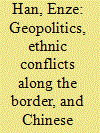

|
|
|
|
|
| Summary/Abstract |
Ever since Myanmar reoriented its foreign policy as a result of its transition to democratic rule in 2010, it has significantly improved its relations with the West, particularly the United States. Amid heightened geostrategic competition between the U.S. and China, how can we understand the Chinese government’s changing approaches to Myanmar, where China’s strategic and economic interests face unprecedented pressure? This article examines those changes in the context of the Chinese government’s response to three militarized ethnic conflicts along its border with Myanmar before and after Myanmar’s foreign policy reorientation. Drawing evidence from Chinese Ministry of Foreign Affairs statements and Chinese media coverage of the 2009 and 2015 Kokang conflicts and the 2011-2013 Kachin conflict, the article argues that combined geopolitical changes and domestic nationalist signaling explain the variations of China’s foreign policy approaches to Myanmar. The article thus contributes to ongoing interest in China’s foreign policy approaches to Southeast Asia in the wake of geostrategic competition between China and the United States.
|
|
|
|
|
|
|
|
|
|
|
|
|
|
|
|
| 20 |
ID:
128854
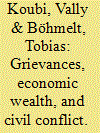

|
|
|
|
|
| Publication |
2014.
|
| Summary/Abstract |
One of the most robust findings in the literature on civil conflicts is that high income levels are associated with a lower risk of conflict onset. This article addresses the wealth-conflict link and discusses it in relation to the dominating `greed vs. grievance' dichotomy. It is further argued that the effect on conflict of grievances, in the form of horizontal inequalities, is conditioned on national wealth. More specifically, there may be a higher risk of civil war in those countries that have much wealth, but where a large share of the population is potentially excluded from accessing it. The empirical analyses testing this argument employ time-series cross-section data for 1951-2004 and find support for the theory. The authors also show that taking this conditional relationship into account improves our ability to predict the onset of civil conflict.
|
|
|
|
|
|
|
|
|
|
|
|
|
|
|
|
|
|
|
|
|